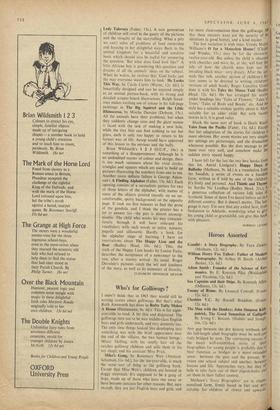Who's for Golliwogs?
I DIDN'T think that in 1965 they would still be writing stories about golliwogs. But that's what Ruth Ainsworth has done in Rufty Tufty Makes A House (Heinemann, 9s. 6d.). This is for eight- year-olds to read. A bit thin and disjointed. The golliwogs turn out to be nice middle-class English boys and girls underneath, and very domestic too. The only time things looked like developing into something was with the brief appearance near the end of the villains, the two human beings : Mister Shilling, with his smelly hair oil (he catches golliwog children and sells them in his toy shop), and his assistant Miss Prick.
Mike's Gang, by Rosemary Weir (Abelard- Schuman, 11S. 6d.), for the ten-year-olds, is much the same sort of thing as the golliwog book. Except that Miss Weir's children are housed in doggy externals. It's supposed to be a gang of dogs, made up of those who have run away or have become outcasts for other reasons. But, sure enough, they are just English boys and girls, and
far more class-conscious than the golliwogs. AU that these outcasts want are the security of in• stitutions (a good home), and a kind master. The last variation is with mice. Ursula Moral' Williams's 0 for a Mouseless House! (Chan.) and Windus, 15s.) may be for the eleven-t0' twelve-year-old. But unless the child is obsessed with churches and mice, he, or she, will find this tale—of how the church mice kept out the invading black mice—very dreary. After the atli' mals that talk, another section of children's fie• tion seems to be devoted to writing children's versions of adult books. Roger Lancelyn Greet does it with his Tales the Muses Told (BodleY .Head, 12s. 6d.). He has arranged his stories under headings like 'Tales of Flowers,' Tales of Trees,' Tales of Birds and Beasts,' etc. And his style has a suitable archaic quality about it. More suitable for an older child. But with twentY -stories in it, it is good value. Much the same sort of book is Doris Ruses Tales from the Pacific (Faber, Its. 6d.). Except that her adaptation of the stories for children i5 more obvious. Her seven stories are very sin pie, her settings are picturesque, and she dramatises whenever possible. But she does manage to pal them over very well, and somehow make the saddest story sound happy.
I have left for the last the two best books from this lot. Astrid Lindgren's Happy Days at Bullerby (Methuen, 9s. 6d.) is a translation from the Swedish, a series of events on a Swedish farm, written as if told by one of the children. It's lively and personal. And Thistle and Throe'. by Sorche' Nic Leodhas (Bodley Head, 21s ). IS a generous collection of various folk tales of Scotland. Some of them I've heard before set 411 different country. But it doesn't matter. The Ian' guage is racy. I'm sure that any exiled Scot, from Saskatoon to Adelaide, wondering what to give his young child or grandchild, can give this WI( with pleasure.
NORMAN LE


































 Previous page
Previous page